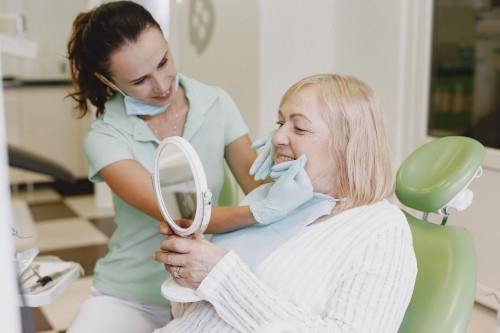Clasp denture
In case of significant damage to the dental row, when conventional prosthetics are impossible (for example, three or more teeth are missing), the doctor may offer a removable orthopedic product on a metal frame (clasp). The technology reduces the thickness of the prosthesis, increases its stability and extends its service life. To use a clasp, good gum condition and the presence of teeth for support are required.

specialists

equipment

treatment
Types of clasp dentures
According to the types of fastenings, the clasp structures are divided into clasp, telescopic, and lock. There are also products created using Quadrotti technology.
Clasp
Telescopic
Lock
Quadrotti design
Clasp dentures for the upper and lower jaw
Clasp dentures for the upper jaw
Dentures for the upper jaw are characterized by a special arch design that adapts to the anatomical features of the patient. The following parameters are usually taken into account:
- Arch thickness. It ranges from 0.9 to 1.2 mm, which ensures the necessary strength and comfort when wearing
- Arch width. It varies from 4 to 10 mm, depending on the size of the defect in the dentition
- Location relative to the mucous membrane. The arch is installed at a distance of approximately 0.5 mm from the mucous membrane, which minimizes discomfort and prevents damage
The structure is attached with clasps, which are located on the lateral incisors or molars. This ensures the stability of the product and the transfer of chewing pressure.
Clasp dentures for the lower jaw
Dentures for the lower jaw require special precision in the manufacture of the arch. It must meet the following requirements as much as possible:
- Distance from the mucous membrane. At the front edge, the arch is installed at approximately 0.5-0.6 mm, and at the bottom - at least 1 mm
- Prevention of injury. The arch should not contact the underlying tissues to prevent irritation and injury to soft tissues
As in the case of the upper jaw, the lower fastening is carried out using clasps located on the lateral incisors.

Modern methods of diagnostics and dental treatment at "K+31"

This award is given to clinics with the highest ratings according to user ratings, a large number of requests from this site, and in the absence of critical violations.

This award is given to clinics with the highest ratings according to user ratings. It means that the place is known, loved, and definitely worth visiting.

The ProDoctors portal collected 500 thousand reviews, compiled a rating of doctors based on them and awarded the best. We are proud that our doctors are among those awarded.
Make an appointment at a convenient time on the nearest date
Price
Other Services



























































What is a partial denture?
Bug denture is a removable product designed to restore partially lost teeth. The design is based on a metal arc, which is located on the palate or under the tongue. The device is fixed on the supporting teeth using metal hooks (clasps). They are divided into 2 types: visible and hidden, which makes the orthopedic product more aesthetic. On the saddle-shaped parts of the product there are artificial teeth that replace lost ones.
The prosthesis transfers chewing pressure to the supporting teeth and gums evenly, which makes it more comfortable to use and reduces the load on the jaw apparatus. Thanks to the metal frame, the design is highly durable and thinner than conventional removable plate analogues.